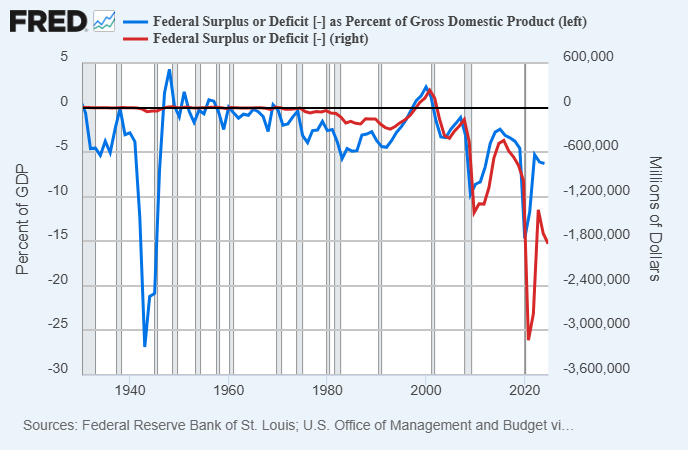A model of this text was initially revealed on lynalden.com.
This article situation analyzes three frequent misconceptions in regards to the US federal debt and deficits.
The continued nature of the deficits has a number of funding implications, however alongside the way in which it’s vital to not get distracted by issues that don’t add up.
Fiscal Debt and Deficits 101
Earlier than I leap into the misconceptions, it’s helpful to shortly remind what the debt and deficits are, particularly.
-In most years, the US federal authorities spends greater than it receives in tax income. That distinction is the annual deficit. We are able to see the deficit over time right here, each in nominal phrases and as a share of GDP:
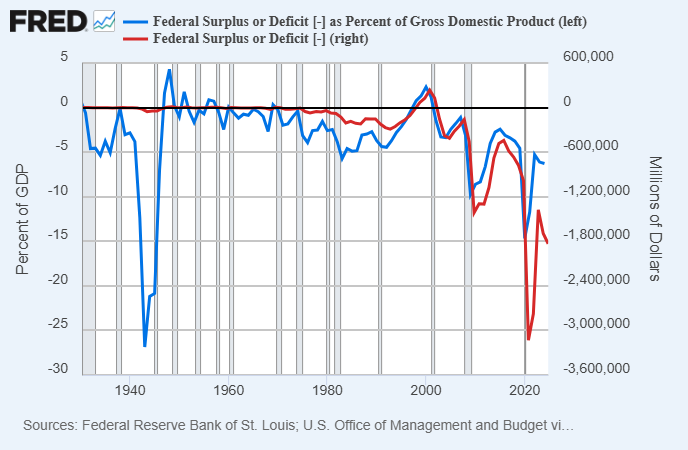
-Because the US federal authorities runs deficits over years and a long time, they add as much as the full excellent debt. That’s the inventory of debt that the US federal authorities owes to lenders, which they pay curiosity on. When a few of their bonds mature, they situation new ones to assist pay again the previous ones.
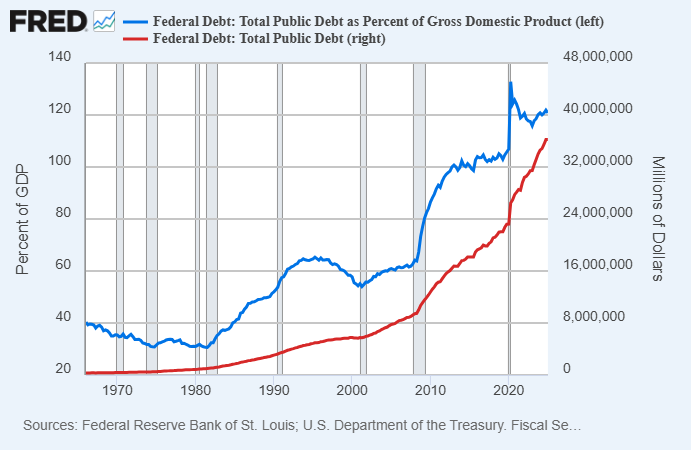
A few weeks in the past at a convention in Las Vegas, I gave a keynote discuss in regards to the US fiscal debt state of affairs (accessible here), which serves as a straightforward 20-minute abstract of the state of affairs.
My view for some time, as outlined in that discuss and for years now, is that US fiscal deficits will likely be fairly massive for the foreseeable future. I’ve mentioned that in quite a few items and codecs, however my September 2024 newsletter was essentially the most detailed breakdown of it, together with Sam Callahan’s January 2025 report.
False impression 1) We Owe it to Ourselves
A typical phrase, popularized by Paul Krugman and others, is that “we owe the debt to ourselves”. Proponents of Fashionable Financial Concept usually make related statements, e.g. saying that the cumulative debt excellent is especially only a tally of surpluses which have been given to the personal sector.
The unsaid implications from that is that the debt isn’t an enormous deal. One other potential implication is that perhaps we may selectively default on parts of it, because it’s simply “owed to ourselves”. Let’s look at these two components individually.
Who It’s Owed To
The federal authorities owes cash to US Treasury safety holders. That features entities in overseas nations, consists of US establishments, and consists of US people. And naturally, these entities have particular quantities of treasuries. The federal government of Japan, for instance, is owed much more {dollars} than me, though we each personal treasuries.
If you happen to, me, and eight different folks exit to dinner in an enormous 10-person group, we owe a invoice on the finish. If all of us ate completely different quantities of meals, then we possible don’t have the identical liabilities right here. The fee usually needs to be cut up in honest methods.
Now in observe for that dinner instance, it’s not an enormous deal as a result of dinner teams are normally pleasant with one another, and individuals are keen to graciously cowl others in that group. However in a rustic of 340 million folks dwelling inside 130 million completely different households, it’s no small matter. If you happen to divide $36 trillion in federal debt by 130 million households, you get $277,000 per family in federal debt debt. Do you take into account that your family’s fair proportion? If not, how will we tally that up?
Put one other method, if in case you have $1 million value of treasuries in your retirement account, and I’ve $100,000 value of treasuries in my retirement account, but each of us are taxpayers, then whereas in some sense “we owe it to ourselves”, it’s actually not in equal measure.
In different phrases, the numbers and proportions do matter. Bondholders count on (usually incorrectly) that their bonds will retain buying energy. Taxpayers count on (once more usually incorrectly) their authorities to keep up sound fundamentals in its foreign money and taxing and spending. That appears apparent, however generally must be clarified anyway.
Now we have a shared ledger, and we’ve got a division of powers about how that ledger is managed. These guidelines can change over time, however the general reliability of that ledger is why the world makes use of it.
Can We Selectively Default?
People, companies, and nations that owe debt denominated in items that they can’t print (e.g. gold ounces or another person’s foreign money) can certainly default in the event that they lack adequate cashflows or property to cowl their liabilities. Nonetheless, developed nation governments, whose debt is normally denominated in their very own foreign money that they will print, not often default nominally. The far simpler path for them is to print cash and debase the debt away relative to the nation’s financial output and scarcer property.
Myself and plenty of others would argue {that a} main foreign money devaluation is a sort of default. In that sense, the US authorities defaulted on bondholders within the Nineteen Thirties by devaluating the greenback vs gold, after which once more within the Nineteen Seventies by decoupling the greenback from gold solely. The 2020-2021 interval was additionally a sort of default, within the sense that the broad cash provide elevated by 40% in a fast time period, and bondholders had their worst bear market in over a century, with vastly decreased buying energy relative to just about each different asset.
However technically, a rustic may additionally default nominally, even when it doesn’t must. Slightly than spreading the ache out with debasement to all bondholders and foreign money holders, they may as a substitute simply default on unfriendly entities, or entities which can be able to resist it, thus sparing foreign money holders broadly, and the bondholders that weren’t defaulted on. That’s a critical risk value contemplating in such a geopolitically strained world.
And so the true query is: are there sure entities for which defaulting has restricted penalties?
There are some entities which have very massive and apparent penalties if they’re defaulted on:
-If the federal government defaults on retirees, or the asset managers holding treasuries on behalf of retirees, then it might impair their potential to assist themselves after a lifetime of labor, and we’d see seniors within the streets in protest.
-If the federal government defaults on insurance coverage corporations, then it impairs their potential to pay out insurance coverage claims, thus hurting Americans in a equally unhealthy method.
-If the federal government defaults on banks, it’ll render them bancrupt, and shopper financial institution deposits gained’t be totally backed by property.
And naturally, most of these entities (those that survive) would refuse to ever purchase a treasury once more.
That leaves some lower-hanging fruit. Are there some entities that the federal government may default on, which could damage much less and never be as existential as these choices? The probabilities are usually foreigners and the Fed, so let’s analyze these individually.
Evaluation: Defaulting on Foreigners
International entities maintain about $9 trillion in US treasuries at present, out of $36 trillion in debt excellent. So, a couple of quarter of it.
And of that $9 trillion, about $4 trillion is held by sovereign entities and $5 trillion is held by overseas personal entities.
The prospect for defaulting on particular overseas entities actually jumped larger in recent times. Previously, the US froze sovereign property of Iran and Afghanistan, however these had been thought of small and excessive sufficient to not rely as any type of “actual” default. Nonetheless, in 2022 after Russia invaded Ukraine, the US and its allies in Europe and elsewhere froze Russian reserves totaling over $300 billion. A freeze isn’t fairly the identical as a default (it is determined by the last word destiny of the property), but it surely’s fairly shut to 1.
Since that point, overseas central banks have turn out to be fairly huge gold consumers. Gold represents an asset that they will custody themselves, and thus is protected towards default and confiscation, whereas additionally being laborious to debase.
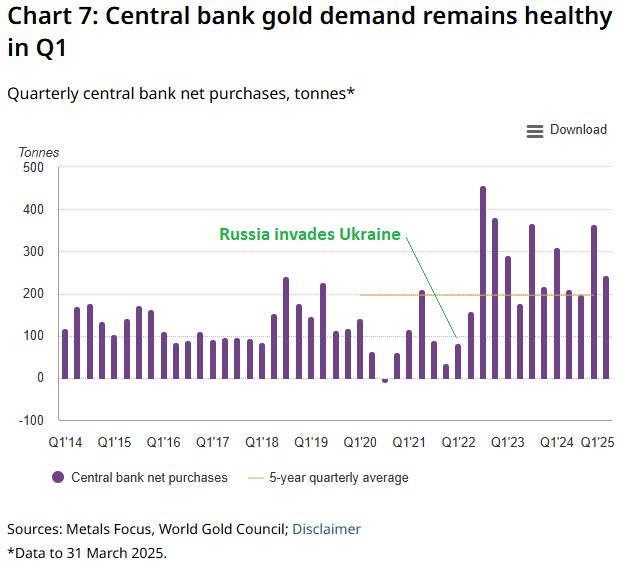
The overwhelming majority of foreign-held US debt is held inside pleasant nations and allies. These are nations like Japan, the UK, Canada, and so forth. A few of them like Cayman Islands, Luxembourg, Belgium, and Eire are haven areas the place loads of establishments arrange store and maintain Treasuries. So, a few of these overseas holders are literally US-based entities which can be integrated in these forms of locations.
China has lower than $800 billion in treasuries now, which is barely about 5 months value of US deficit spending. They’re close to the highest of the potential “selective default” threat spectrum, and so they’re conscious of it.
If the US had been to default at a big scale on some of these entities, it might vastly impair the flexibility for the US to persuade overseas entities to carry their treasuries for a very long time. The freezing of Russian reserves already despatched a sign that nations responded to, however in that occasion that they had the duvet of a literal invasion. Defaulting on debt held by non-aggressive nations can be seen as a transparent and apparent default.
So, this isn’t a very viable choice general, though there are specific pockets the place it’s not out of the realm of risk.
Evaluation: Defaulting on the Fed
The opposite choice is that the Treasury may default on the treasuries that the US Federal Reserve holds. That’s slightly over $4 trillion at present. In spite of everything, that’s the closest model of “we owe it to ourselves” proper?
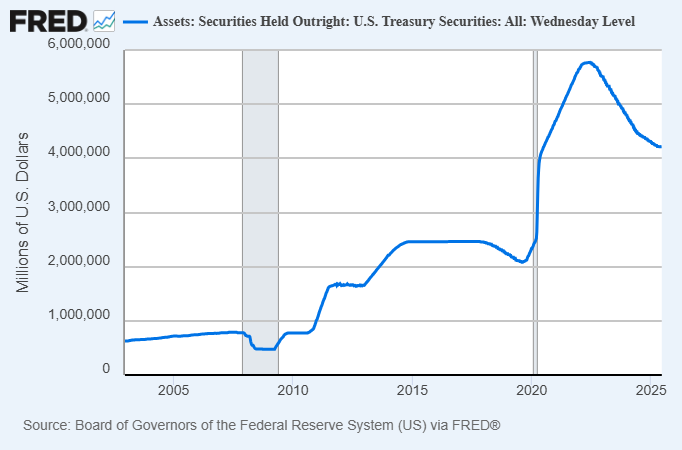
There are main issues with that, too.
The Fed, like several financial institution, has property and liabilities. Their major liabilities are 1) bodily foreign money and a pair of) financial institution reserves owed to business banks. Their major property are 1) treasuries and a pair of) mortgage-backed securities. Their property pay them curiosity, and so they pay curiosity on financial institution reserves in an effort to set an rate of interest flooring and decelerate banks’ incentive to lend and create extra broad cash.
Presently, the Fed is sitting on main unrealized losses (lots of of billions) and is paying out extra curiosity than they obtain every week. In the event that they had been a traditional financial institution, they’d expertise a financial institution run and be shut down. However as a result of they’re the central financial institution, no one can do a financial institution run on them, to allow them to function at a loss for a really very long time. They’ve racked up over $230 billion in cumulative web curiosity losses over the previous three years:

If the Treasury had been to completely default on the Fed, it might render them massively bancrupt on a realized foundation (they’d have trillions extra in liabilities than in property), however because the central financial institution they’d nonetheless be capable of keep away from a financial institution run. Their weekly web curiosity losses can be even higher, as a result of they’d have misplaced most of their curiosity revenue at that time (since they’d solely have their mortgage backed securities).
The primary downside with this method is that it might impair any notion of central financial institution independence. The central financial institution is meant to be largely separate from the manager department, and so for instance the President can’t minimize rates of interest earlier than an election and lift rates of interest afterward, and do shenanigans like that. The President and Congress put the Fed’s board of governors in place with lengthy phrases of service, however then from there the Fed has its personal funds, is mostly imagined to run profitably, and assist itself. A defaulted-on Fed is an unprofitable Fed, and with main detrimental fairness. That’s a Fed that’s now not impartial, and doesn’t even have the phantasm of being impartial.
One potential option to mitigate that is to remove the Fed’s curiosity funds to business banks on their financial institution reserves. Nonetheless, that curiosity is there for a purpose. It’s a part of how the Fed units an rate of interest flooring in an ample-reserves setting. Congress may go laws that 1) forces banks to carry a sure share of their property in reserves and a pair of) eliminates the Fed’s potential to pay them curiosity on these reserves. That may push extra of the issue towards business banks.
That final choice is likely one of the extra viable paths, with contained penalties. Financial institution buyers (fairly than depositors) can be impaired, and the Fed’s potential to affect rates of interest and financial institution lending volumes can be impaired, but it surely wouldn’t be an in a single day catastrophe. Nonetheless, the Fed solely holds about two years’ value of federal deficits, or about 12% of complete federal debt excellent, in order that considerably excessive monetary repression situation would simply be a bandage for the issue.
In brief, we don’t owe the debt to ourselves. The federal authorities owes it to particular entities, home and worldwide, who can be impaired in consequential methods if defaulted on, and plenty of of these methods would ricochet again into hurting each the federal authorities and US taxpayers.
False impression 2) Folks Have Been Saying This for Many years
One other frequent factor you’ll hear in regards to the debt and deficit is that folks have been calling it an issue for many years, and it has been wonderful sufficient. The implication from this view is that the debt and deficit aren’t an enormous deal, and people who say it’s an enormous deal find yourself prematurely “calling wolf” over and over and may be safely ignored.
Like many misconceptions, there’s a grain of reality right here.
As I’ve identified earlier than, the “peak zeitgeist” for the concept that the federal debt and deficit is an issue was again within the late Nineteen Eighties and early Nineteen Nineties. The well-known “debt clock” was put up in New York within the late Nineteen Eighties, and Ross Perot ran essentially the most profitable impartial presidential marketing campaign in trendy historical past (19% of the favored vote) largely on the subject of debt and deficits. This was again when rates of interest had been very excessive, and so curiosity expense was an enormous share of GDP:
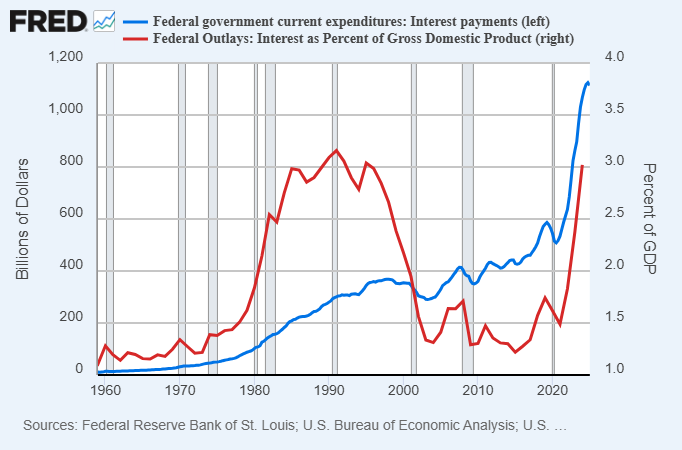
Individuals who referred to as for the debt to spiral uncontrolled again then had been certainly flawed. Issues had been wonderful for many years. Two primary issues occurred that allowed that to be the case. The primary is that the opening of China within the Nineteen Eighties and the autumn of the Soviet Union within the early Nineteen Nineties had been very deflationary forces for the world. Huge quantities of jap labor and sources had been capable of join with western capital, and produce a ton of latest provide of every part to the world. The second is that, partially due to this, rates of interest had been capable of hold heading decrease, which made curiosity expense on the rising complete inventory of debt extra manageable within the Nineteen Nineties, 2000s, and 2010s.
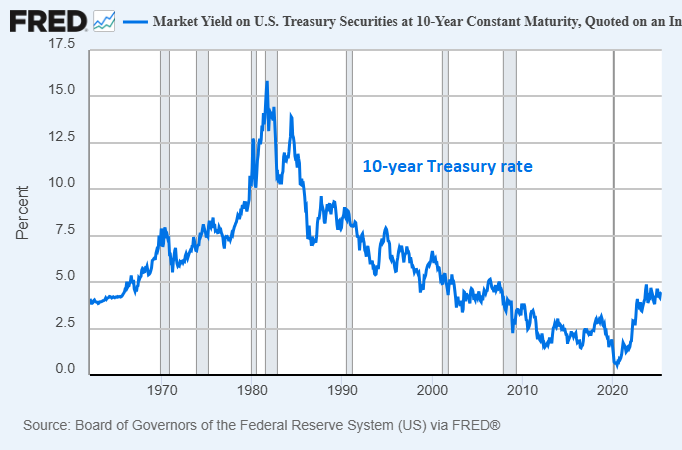
So sure, if somebody was speaking in regards to the debt being an imminent downside 35 years in the past and remains to be speaking about it at the moment, I can see why somebody would select to only type of tune them out.
Nonetheless, folks shouldn’t fall too far within the different course, and assume that because it didn’t matter in this time period, that it gained’t matter ever. That may be a fallacy.
A number of pattern adjustments occurred within the late 2010s. Rates of interest hit zero and since then are now not in a structural downtrend. Child Boomers began retiring, resulting in the Social Safety belief reaching peak ranges and getting into drawdown mode, and globalization reached a possible peak, with thirty years of western capital and jap labor/sources connecting collectively being largely completed (and now probably reversing barely across the margins).
Some pattern adjustments, visualized:
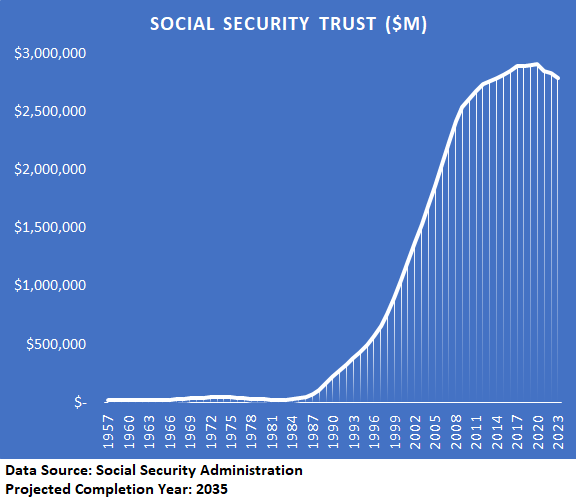
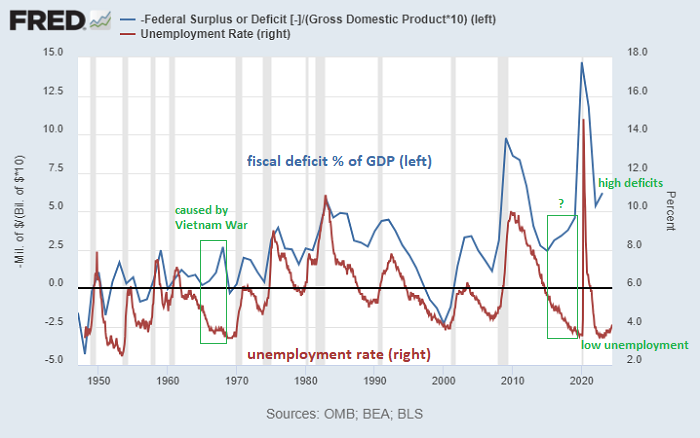
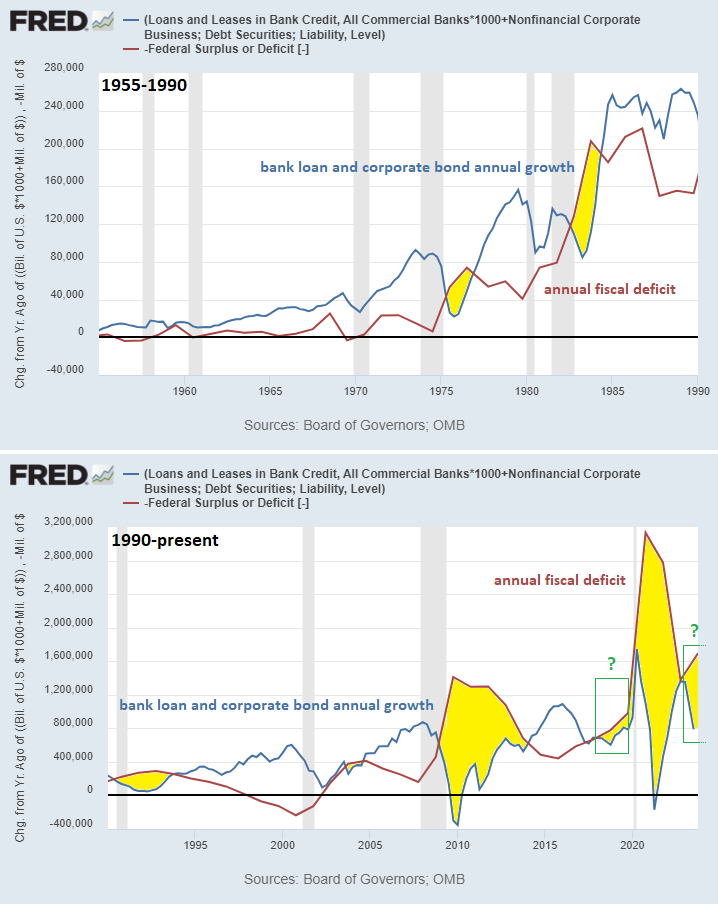
We’re not on the level the place the debt or deficits are going to trigger a large prepare wreck any time quickly. Nonetheless, we’re properly into the period the place the deficits do matter and have penalties.
For six years now, after seeing the opening phases of a few of these pattern adjustments, I’ve been emphasizing fiscal spending as an more and more huge portion of macroeconomics and funding selections in trendy occasions. It has been my major “north star” when making an attempt to navigate this fairly hectic macro setting through the years.
Taking the debt and deficit significantly since these pattern adjustments started occurring has been a great way to 1) not be shocked by among the issues which have occurred and a pair of) run a portfolio extra efficiently than a typical 60/40 inventory/bond portfolio.
-My 2019 article “Are We in a Bond Bubble?” was the prologue. My conclusion was that sure, we’re possible in a bond bubble, that the combo of fiscal spending and central financial institution debt monetization generally is a lot extra impactful and inflationary than folks appear to imagine, and that such a factor is probably going coming within the subsequent downturn. In early 2020 I wrote “The Subtle Risks of Treasury Bonds” which warned about extreme debasement. Bonds went on to have their worst bear market in over a century within the 5-6 years since these items.
-Throughout the depths of the disinflationary shock in March 2020, I wrote “Why This is Unlike the Great Depression” which emphasised how huge fiscal stimulus (i.e. deficits) was beginning, and would possible get us again to nominal inventory highs sooner than folks assume, albeit on the possible value of excessive inflation.
-For the remainder of 2020, I adopted it up with a collection of articles reminiscent of “QE, MMT, and Inflation/Deflation”, “A Century of Fiscal and Monetary Policy” and “Banks, QE, and Money-Printing” which explored why the massive combo of fiscal stimulus and central financial institution assist can be considerably completely different than the financial institution recapitalization QE of 2008/2009. In brief, the thesis was that this was extra like inflationary Nineteen Forties conflict finance than deflationary Nineteen Thirties personal debt deleveraging, thus a place of equities and laborious monies can be higher than bonds. As a bond bear, I spent a whole lot of time debating bond bulls on this topic.
-By spring 2021, shares had already jumped a ton and value inflation certainly started to interrupt out. My Might 2021 publication “Fiscal-Driven Inflation” described and projected the difficulty additional.
-The 12 months 2022 was the one 12 months the place I obtained fairly cautious across the thought of fiscal consolidation and potential recession, as value inflation reached its peak and pandemic-era fiscal stimulus wore off. My January 2022 publication “The Capital Sponge” was considered one of my early framings of the scene. Most of 2022 was certainly a foul 12 months for broad asset costs and the economic system slowed significantly, however by most metrics a recession was averted attributable to what began occurring later within the 12 months.
-By late 2022 and notably by early 2023, fiscal deficits had been increasing once more, in vital half attributable to ballooning curiosity expense on the general public debt amid the fast enhance in rates of interest. The Treasury Common Account was draining liquidity again into the banking system, the Treasury Division shifted towards extra T-bill issuance which was a pro-liquidity transfer to drag cash out of the reverse repo facility and again into the banking system, and general it was “recreation on” once more by way of deficit enlargement. My July 2023 publication was referred to as “Fiscal Dominance” and centered on this matter.
-By October 2023, federal fiscal 12 months 2023 was within the books (which runs from October 2022 by September 2023) with a brand new nominal deficit enhance, and I began my “nothing stops this prepare” meme in regards to the topic (initially from the present Breaking Unhealthy however on this context referring to US fiscal deficits) with this tweet:
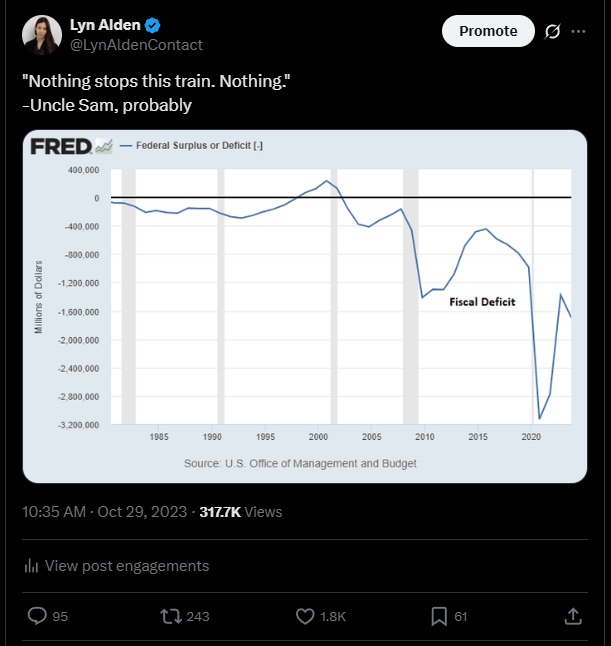
I hold highlighting it, as a result of it will get the purpose throughout successfully:

My level right here is that we are actually firmly in an period the place the full inventory of debt and ongoing federal deficits have actual affect. Relying on whether or not you’re on the receiving aspect of these deficits or not, you would possibly really feel these deficits have extra constructive or detrimental impacts, however nonetheless they’ve impacts. These impacts are capable of be measured and reasoned about, and thus have financial and funding implications.
False impression 3) The Greenback Will Collapse Quickly
The prior two misconceptions countered the broad concept that the debt doesn’t matter.
This third one is a bit completely different as a result of it counters the notion that issues are going to explode tomorrow, subsequent week, subsequent month, or subsequent 12 months.
People who declare issues will blow up quickly are inclined to fall into considered one of two camps. The primary camp is that they profit from sensationalism, clicks, and so forth. The second camp is that they genuinely misunderstand the state of affairs. Many individuals within the second camp don’t do a whole lot of evaluation on overseas markets to see really how a lot it takes for a sovereign bond market to explode.
The US is operating 7% of GDP deficits, kind of. As I’ve argued quite a few occasions, that’s largely structural and really laborious to meaningfully scale back now or for the following decade. Nonetheless, it’s not 70% of GDP deficits. Magnitude issues.
There are some vital metrics to quantify right here.
-The federal authorities has a bit over $36 trillion in debt. To place that in context, US households collectively have $180 trillion in property, or $160 trillion in web value after liabilities (largely mortgages) are subtracted. Nonetheless, since we don’t “owe it to ourselves”, that is considerably of an apples to oranges comparability, but it surely’s useful for placing massive numbers into context.
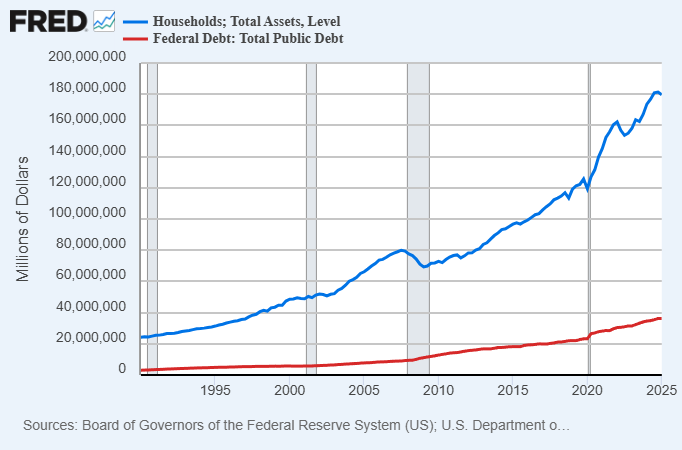
-The US financial base is about $6 trillion. There’s over $120 trillion value of dollar-denominated loans and bonds excellent in complete (private and non-private, home and worldwide, excluding derivatives). Within the overseas sector alone, there may be about $18 trillion value of dollar-denominated debt, which is 3x as a lot as there are base {dollars} in existence.
What this implies is that there’s an extremely great amount of rigid demand for {dollars} domestically and all through the world. Everybody who owes {dollars}, wants {dollars}.
When a rustic like Turkey or Argentina hyperinflates or nearly-so, it’s in a context the place virtually no one exterior of their nation wants their lira or pesos. There’s no entrenched demand for his or her foreign money. And so, if their foreign money turns into undesirable for any purpose (normally attributable to fast cash provide development), it’s very simple to only repudiate it and ship its worth to Hades.
The identical just isn’t true for the greenback. All of that $18 trillion in foreign-owed debt represents rigid demand for {dollars}. Most of that isn’t owed to the US (the US is a web debtor nation), however the foreigners don’t “owe that debt to themselves” both. Numerous particular entities all over the world contractually owe numerous different particular entities all over the world a sure variety of {dollars} by a sure date in time, and thus must continually attempt to get their palms on {dollars}.
The truth that they collectively owe extra {dollars} than there are base {dollars} in existence is vital. That’s why the financial base can double, triple, or extra, and never be outright hyperinflationary. It’s nonetheless a small enhance relative to how a lot contractual demand there may be for {dollars}. When excellent debt vastly exceeds the variety of base items, it takes a ton of printing of base items to render that base unit nugatory.
In different phrases, folks severely underestimate how a lot cash provide development america can expertise earlier than it might end in a real greenback disaster. It’s not laborious to create politically problematic ranges of inflation or different points, however creating a real disaster is one other story.
Consider the debt and deficit as being a dial, not a swap. Many individuals ask “when will it matter?” as if it’s a light-weight swap the place it goes from not an issue to a disaster. However the reply is that it’s normally a dial. It already issues now. We’re already operating issues sizzling. The Fed’s potential to modulate the expansion of complete new credit score is already impaired, thus placing them right into a state of fiscal dominance. However the remainder of that dial has a lot of room to show earlier than it really reaches the tip.
That’s why I take advantage of the phrase “nothing stops this prepare”. The deficits are extra intractable than the bulls assume, which means it’s very unbelievable that the US federal authorities goes to get them below management any time quickly. However however, it’s not as imminent as bears assume; it’s unlikely to trigger an outright greenback disaster any time quickly. It’s a really lengthy sluggish movement prepare wreck. A dial steadily being turned increasingly.
Positive, we will have mini-crises, just like the 2022 UK Gilt Disaster. And once they occur, a number of hundred billion {dollars} can usually put out the fireplace at the price of debasement.
Suppose that bond yields escape to the purpose of rendering banks bancrupt or the Treasury market acutely illiquid. The Fed can step in with QE or yield suppression. Sure, that comes with the price of potential value inflation and has implications for asset costs, however no, it’s not hyperinflationary on this context.
Within the lengthy arc of time, sure the greenback will face main issues. However nothing signifies catastrophic points within the near-term except we rip ourselves aside socially and politically (which might be a separate matter than the numbers, and thus is exterior of the scope of this text).
Right here is a few extra context. The US had 82% cumulative broad cash provide development over the previous decade. Egypt had 638% broad cash provide development throughout that very same time interval. And the Egyptian pound underperformed the greenback by roughly that ratio; a decade in the past a US greenback was value a bit below 8 Egyptian kilos, and at the moment it’s value a bit over 50 Egyptian kilos. Egyptians handled double-digit value inflation for many years on this decade.
I spend a part of every year dwelling in Egypt. Issues haven’t been simple there. They’ve recurring power shortages and financial stagnation. However life goes on. Even that stage of foreign money debasement was not sufficient to offer them an outright disaster, particularly with entities just like the IMF round to maintain them totally on the tracks towards ever-more debt and debasement.
Think about how a lot it might take to place the greenback into that state of affairs, not to mention a worse state of affairs, when conserving in thoughts how a lot rigid demand there may be for {dollars}. When folks assume the greenback goes to break down quickly, I usually assume they haven’t traveled a lot and/or haven’t studied different currencies. Issues can go quite a bit additional than folks assume and nonetheless be semi-functional.
For some extra figures, China had 145% broad cash provide development over the previous decade. Brazil had 131%. India had 183%.
Put one other method, the greenback just isn’t going to leap straight from a developed market foreign money to a collapsed one. Alongside the way in which, it has to undergo “growing market syndrome”. International demand for the greenback could weaken over time. Ongoing funds deficits and an more and more captured Fed could end in steadily accelerating cash provide development and monetary repression. Our structural commerce deficit offers us with a foreign money vulnerability that nations with structural commerce surpluses don’t have. However we’re ranging from a developed market base with an entrenched world community impact, and as issues worsen, our foreign money may resemble the foreign money of a growing market in some ways. It may look extra like Brazil’s foreign money, then Egypt’s, then Turkey’s, over fairly an extended timeframe. It doesn’t leap from being the US greenback to the Venezuelan bolivar in the middle of a 12 months and even 5 years, wanting one thing like a nuclear strike or a civil conflict.
Placing this all collectively, the spiraling US debt and deficit state of affairs does certainly have more and more actual penalties, each within the current and ahead into the longer term. It’s not ignorable just like the “every part is okay” camp would have you ever imagine, neither is it as imminently catastrophic because the sensationalist aspect would have you ever imagine. It’s more than likely an intractable situation that’s going to be with us as a background issue to take care of for fairly a very long time, and buyers and economists must take that under consideration in the event that they’re going to make correct calls.
Closing Ideas: Bitcoin Checkup
In line with most indicators that I monitor, I proceed to view bitcoin as possible having larger to go on this cycle earlier than the provision/demand stability turns into exhausted and has an enormous shake-out.
Bitcoin has actually come a good distance. On the floor, $103,000 would maybe even appear costly. I publicly recommended it at below $10k in 2020, and haven’t let up since. Shouldn’t I take earnings at this level? Over 5 years later and up tremendously?
Whereas I do rebalance in my mannequin portfolios, I don’t promote any of my cold-storage bitcoin, which represents the majority of my place. One purpose for that’s as a result of even at this seemingly excessive value stage, the entire Bitcoin community is barely value greater than $2 trillion.
That is in a world of about $1 quadrillion value of property throughout all asset lessons. Gold is estimated to be value about $20 trillion, or 2% of estimated property. Bitcoin is a tenth of that, or round 0.2% of property. Because the community impact continues to develop, and because the resilience of the know-how continues to be examined in quite a lot of methods, I feel it has quite a bit additional to develop so long as it avoids sure tail threat outcomes that may impair its precise functioning.
In prior cycles, bitcoin had huge blow-off tops by way of market worth relative to on-chain value foundation. This present cycle has been extra gradual up to now, which is smart on condition that it’s a bigger and extra liquid asset now. Intervals of delicate overexuberance have been met by six-month consolidations to let off some steam, after which it might grind as much as the following stage.
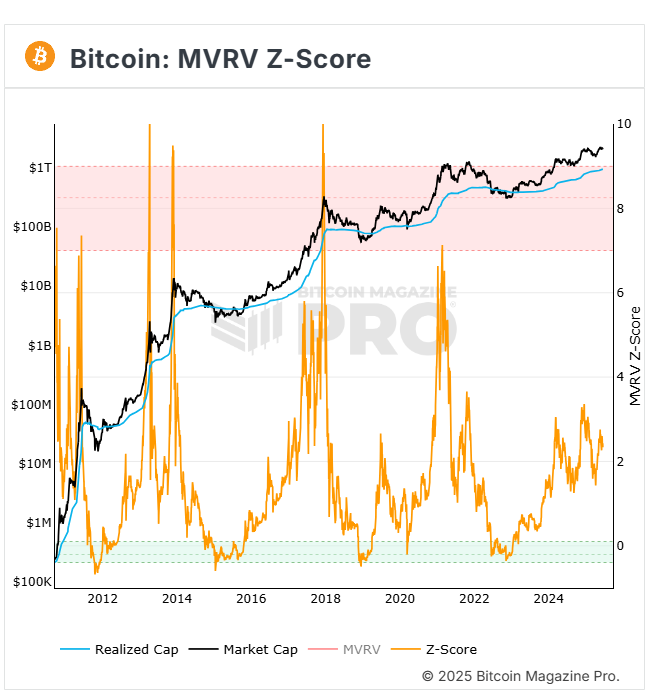
As complete credit score within the US and world system continues to develop over the following 5 or ten years, scarce property at cheap valuations are more likely to proceed to be worthwhile issues to personal. This could embody high-quality equities, actual property in non-bubbly markets, treasured metals, and bitcoin.
Greatest regards,

